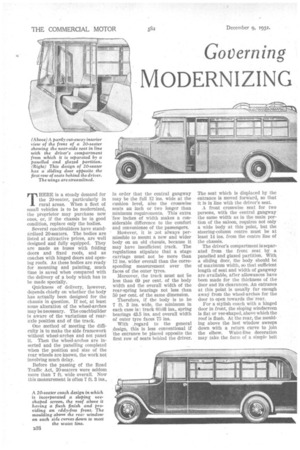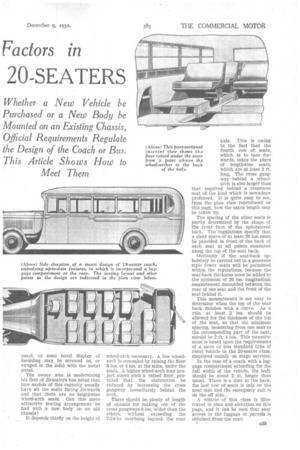Governing Factors in
Page 52

Page 53

If you've noticed an error in this article please click here to report it so we can fix it.
MODERNIZING 20-SEATERS
THERE is a steady demand for the 20-seater1 particularly in rural areas. When a fleet of small vehicles is to be modernized, the proprietor may purchase new ones, or, if the chassis be in good condition, replace only the bodies.
Several coachbnilders have standardized 20-seaters. The bodies are listed at attractive prices, are well designed and fully equipped. They are made as buses with folding doors and fixed roofs, and as coaches with hinged doors and opening roofs. As these bodies are ready for mounting and painting, much time is saved when compared with the delivery of a body which has to be made specially.
Quickness of delivery, lkowever, depends chiefly on whether the body has actually been designed for the chassis in question. If not, at least some alteration of the wheel-arches may be necessary. The coachbuilder is aware of the variations of rearaxle position and of the track.
One method of meeting the difficulty is to make the side framework without wheel-arches and not panel it. Then the wheel-arches are inserted and the panelling completed when the position and size of the rear wheels are known, the work not involving much delay.
Before the passing of the Road Traffic Act, 20-seaters were seldom more than 7 ft. wide overall. Now this measurement is often 7 ft. 3 ins.,
in order that the central gangway may be the full 12 ins, wide at the cushion level, also the crosswise seats an inch or two longer than minimum requirements. This extra -few inches of width makes a considerable difference to the comfort and convenience of the passengers.
HoviTever, it is not always permissible to mount a new and wider body on an old chassis, because it may have insufficient track. The regulations stipulate that a stage carriage must not be more than 12 ins, wider overall than the corresponding measurement over the faces of the outer tyres.
Moreover, the track must not be less than 69 per cent, of the body width and the overall width of the rear-spring bearings not less than 50 per cent. of the same dimension.
Therefore, if the body is to be 7 ft. 3 ins, wide, the minimum in each case is: track 60.03 ins., spring bearings 43.5 ins, and overall width of outer tyre faces 75 ins.
With regard to the general design, this is less conventional if the entrance be placed opposite the first row of seats behind the driver. The seat which is displaced by the entrance is moved forward, so that it is in line with the driver's seat.
A front crosswise seat for two persons, with the central gangway the same width as in the main portion of the saloon, requires not only a wide body at this point, but the steering-column centre must be at least 14 ins, from the centre line of the chassis.
The driver's compartment is separated from the front seat by a panelled and glazed partition. With a sliding door, the body should be of maximum width, so that sufficient length of seat and width of gangway are available, after allowances have been made for the thickness of the door and its clearances. An entrance at this point is usually far enough away from the wheel-arches for the door to open towards the rear.
For a stylish coach with a hinged door in front, the sloping windscreen is flat or vee-shaped, above which the roof is flush. At the rear, the moulding above the last window sweeps down with a return curve to join the elbow. Waist-line decoration may take the form of a simple belt
panel, or some novel display of moulding may be screwed on, or swaged in the solid with the metal panel.
The owner who is modernizing his fleet of 20-seaters has noted that new models of this capacity usually have all the seats facing forwards and that there are no• lengthwise wheel-arch seats. Can this more attractive seating arrangement be had with a new body on an old chassis?
It depends chiefly on the height of wheel-arch necessary. A low wheelarch is concealed by raising the floor 3 ins. or 4 ins, at the sides, under the seats. A higher wheel-arch may project above such a raised floor, provided that the obstruction be reduced by increasing the cross gangway immediately behind the arch.
There should be plenty of length of chassis for making one of the cross gangways 6 ins, wider than the others, without exceeding the 7-24ths overhang beyond the rear axle. This is owing to the fact that the fourth row of seats, which is to face forwards, takes the place of lengthwise seats, which are at least 3 ft. long. The cross gangway behind a wheelarch is also larger than that required behind a tranverse seat of the kind which is nowadays preferred. It is quite easy to see, from the plan view reproduced on this page, how the extra length may be taken up.
The spacing of the other seats is partly determined by the shape of the front face of the upholstered back. The regulations specify that a clear space of at least 26 ins, must be provided in front of the back of each seat at all points measured along the top of the seat back.
Obviously if the seat-back upholstery be carried out in a generous style fewer seats will be permitted within the regulations, because the seat-hack thickness must be added to the minimum of 26 ins, longitudinal measurement demanded between the rear of one seat and the front of the seat behind it.
This measurement is not easy to determine when the top of the seat back finishes with a curve. As a rule, at least 2 ins, should be allowed for the thickness of the top of the seat, so that the minimum spacing, measuring from one seat to the corresponding part of the next, should be 2 ft. 4 ins. This measurement is based upon the requirements of a more or less standard type of rural vehicle in the 20-seater class, employed mainly on stage services.
In the case of a coach with a luggage compartment extending for the full width of the vehicle, the body should be about 2 ft. longer than usual. There is a door at the back, the last row of seats is only on the near side and the emergency exit is on the off side.
A vehicle of this class is illustrated in plan and elevation on this page, and it can be seen that easy access to the luggage or parcels is obtained from the rear.




























































































